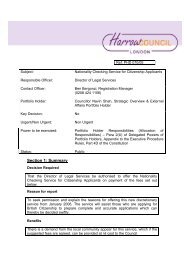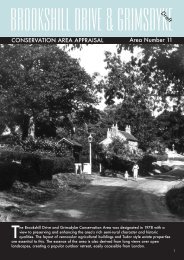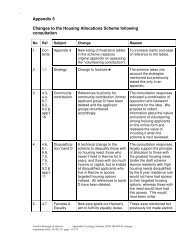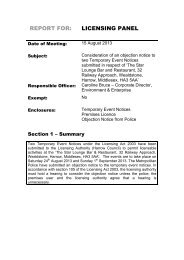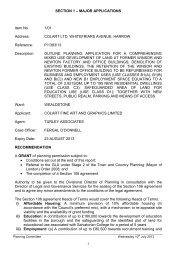London Fire Safety Guidance for Houses in ... - Harrow Council
London Fire Safety Guidance for Houses in ... - Harrow Council
London Fire Safety Guidance for Houses in ... - Harrow Council
Create successful ePaper yourself
Turn your PDF publications into a flip-book with our unique Google optimized e-Paper software.
Surface F<strong>in</strong>ishesWALLS, PARTITIONS, CEILINGS AND SOFFITSIn the early stages of a fire, the safety of a build<strong>in</strong>g’s occupants can beaffected by the properties of surface l<strong>in</strong><strong>in</strong>gs and f<strong>in</strong>ishes to walls, partitions,ceil<strong>in</strong>gs and soffits. Rapid spread of flame across surfaces allows the fire tospread more rapidly through the build<strong>in</strong>g, thereby reduc<strong>in</strong>g the time <strong>for</strong>escape. This is of particular concern <strong>in</strong> escape routes, especially <strong>in</strong> s<strong>in</strong>glestaircase build<strong>in</strong>gs.Classification of materials and products <strong>for</strong> surface spread of flameTwo British Standard tests exist;• BS 476: Part 7: 1971/1987/1997 “Method of classification of the surfacespread of flame of products”.This details a test <strong>for</strong> determ<strong>in</strong><strong>in</strong>g the rate of spread of flame across theexposed surface of a material/product. It classifies per<strong>for</strong>mance from Class 1to Class 4 (Class 1 be<strong>in</strong>g the highest per<strong>for</strong>mance/slowest spread of flameand Class 4 the lowest per<strong>for</strong>mance/most rapid spread of flame)• BS 476: Part 6 “Method of test <strong>for</strong> fire propagation of products”This details a test <strong>for</strong> determ<strong>in</strong><strong>in</strong>g the ease of ignition, rate of heat release <strong>in</strong>fire and other properties of materials and products. It gives a Class 0 rat<strong>in</strong>g <strong>for</strong>those materials/products which are found to be of limited combustibility or tohave a low fire propagation <strong>in</strong>dex.When assess<strong>in</strong>g materials/products <strong>for</strong> their suitability <strong>in</strong> a particular HMOlocation, it is necessary to ensure the material/product’s classification meetsor exceeds the m<strong>in</strong>imum required. (Class 0 will satisfy Class 0, 1, 2, 3 and 4locations. Class 1 will satisfy Class 1, 2, 3 and 4 locations but not Class 0locations, etc. This can only be done by reliance upon a valid test report froma UKAS (ex NAMAS) registered test<strong>in</strong>g house. The report will detail theproduct and give it a classification from 0 to 4. (Class 0 will quote Part 6 of theabove British Standard and Classes 1-4 will quote Part 7.) For proprietaryproducts it is essential to ensure that the product <strong>in</strong>stalled on site does notdiffer <strong>in</strong> any way from that <strong>in</strong> the test report specification. M<strong>in</strong>or differences <strong>in</strong>thickness, substrate, colour, fix<strong>in</strong>gs, adhesive etc. may affect the rat<strong>in</strong>g andper<strong>for</strong>mance.Standard required <strong>in</strong> HMOsWith the exception of small areas of wall surfaces the surface f<strong>in</strong>ishes ofwalls, partitions, ceil<strong>in</strong>gs and soffits should meet the m<strong>in</strong>imum standard <strong>in</strong> thefollow<strong>in</strong>g table.<strong>London</strong> <strong>Fire</strong> <strong>Safety</strong> <strong>Guidance</strong> <strong>for</strong> <strong>Houses</strong> <strong>in</strong> Multiple OccupationVersion 2: 06/06







